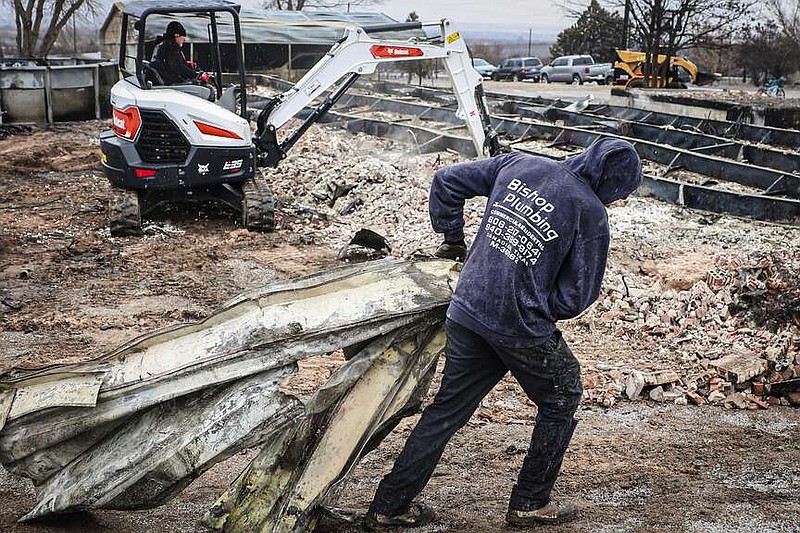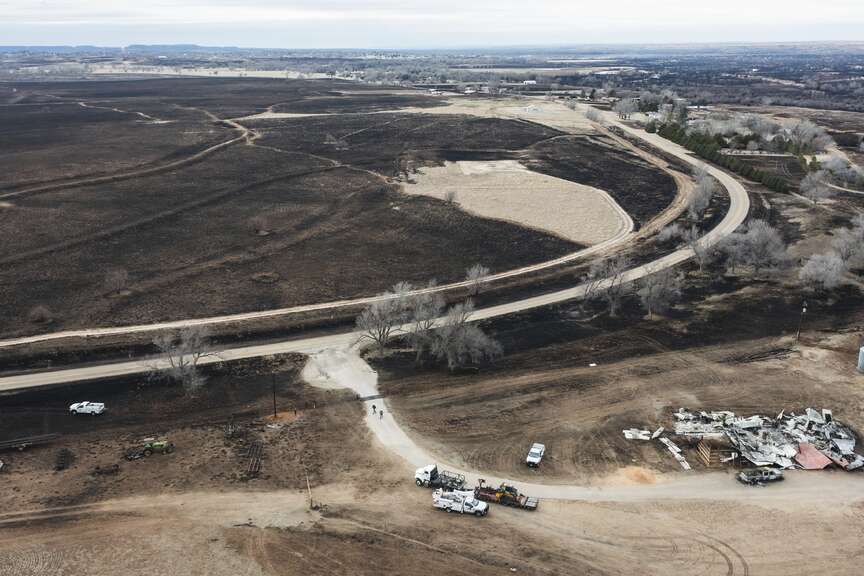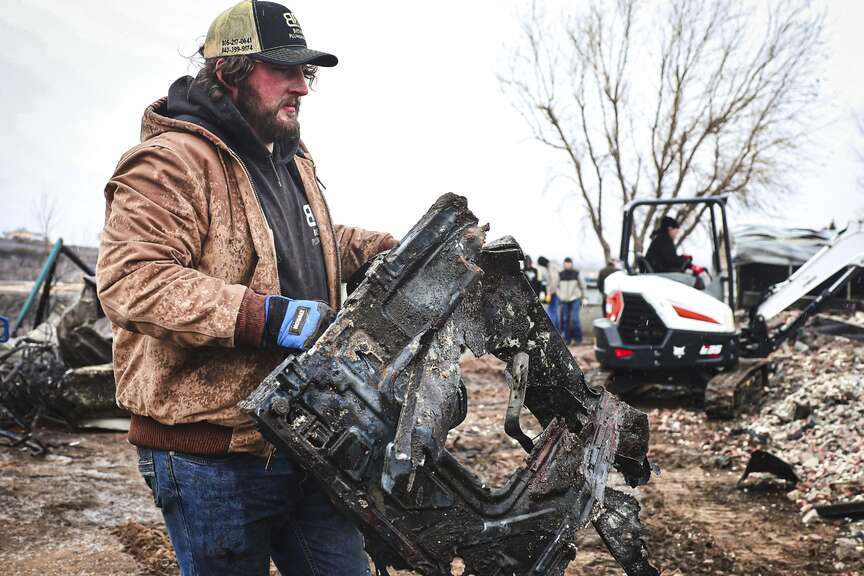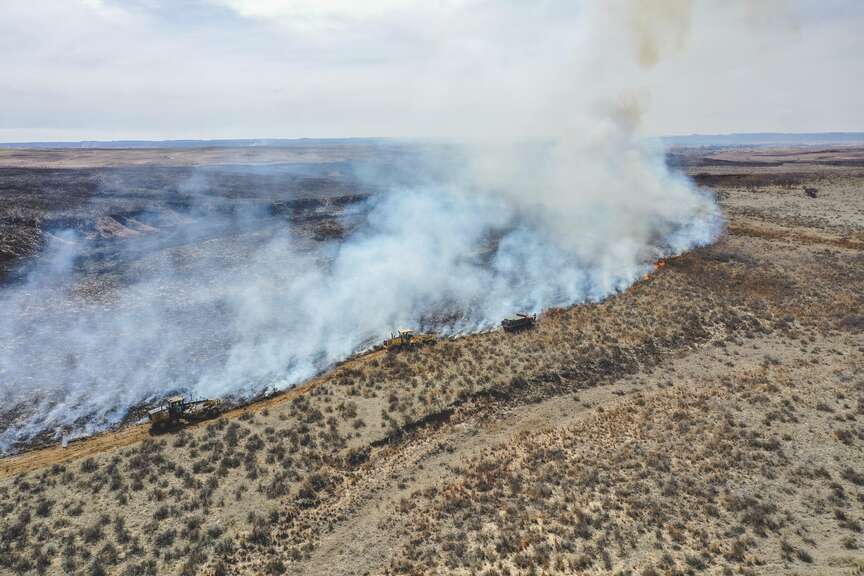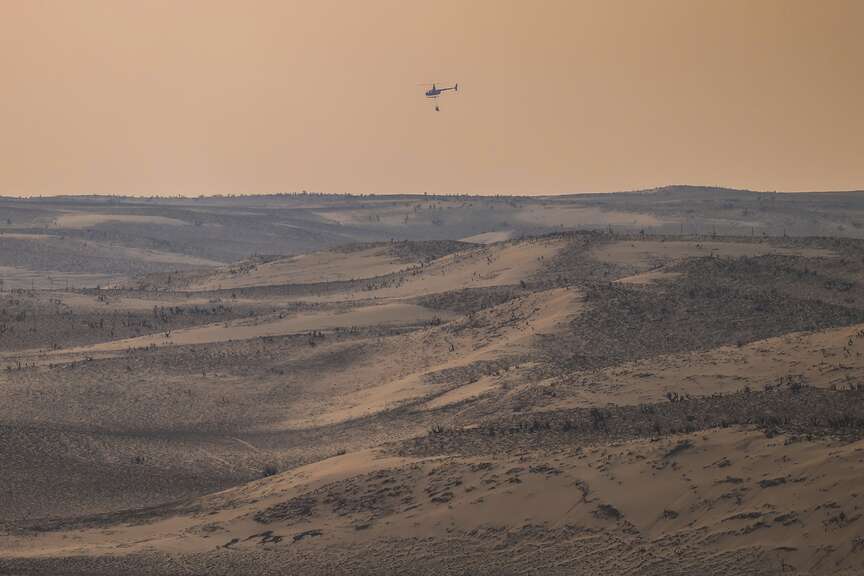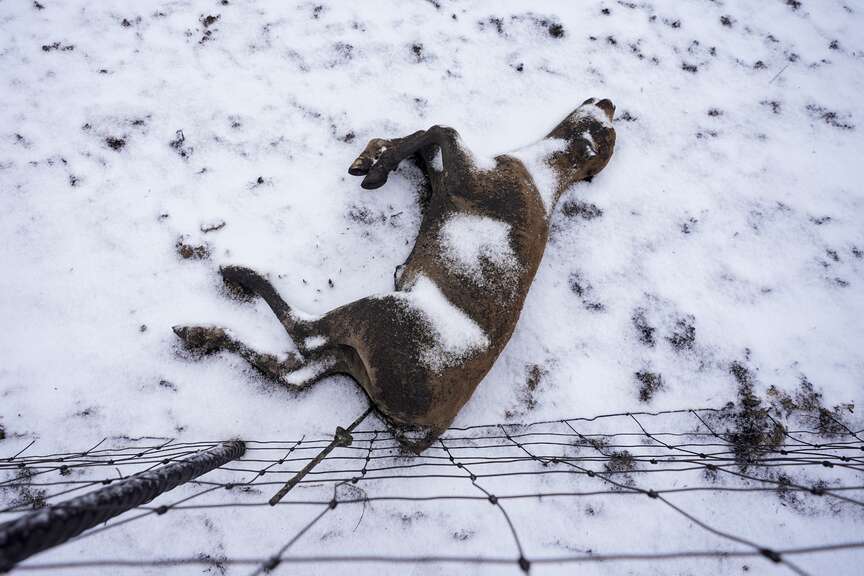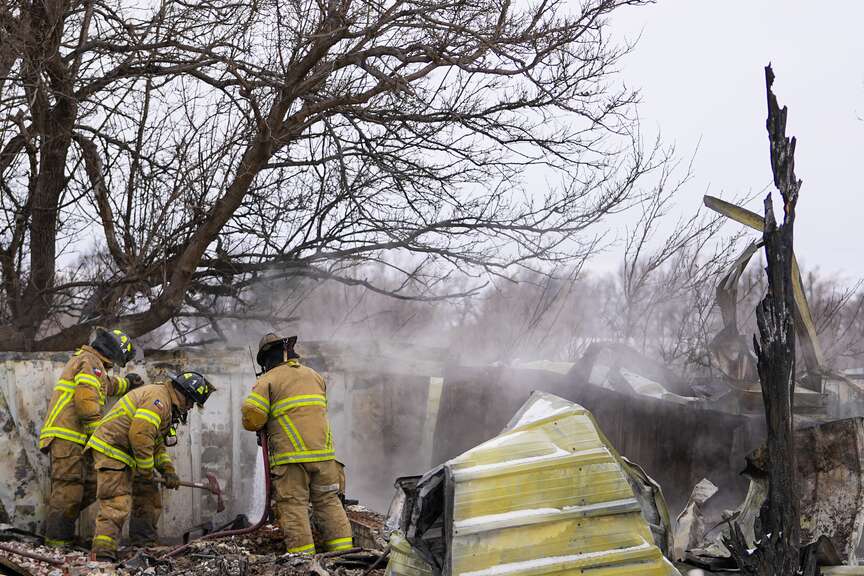STINNETT, Texas (AP) -- Wildfires have destroyed as many as 500 structures in the Texas Panhandle, Republican Gov. Greg Abbott said Friday, describing how the largest blaze in state history destroyed everything in its path, leaving ashes in its wake.
The Smokehouse Creek fire, which began Monday, has burned about 1,700 square miles, killed at least two people, and left a charred landscape of scorched prairie, dead cattle and burned-out homes. The cause of the fire remains under investigation, although strong winds, dry grass and unseasonably warm weather fed them.
"When you look at the damages that have occurred here it's just gone, completely gone nothing left but ashes on the ground," Abbott said during a news conference in Borger, Texas, adding that a preliminary assessment found 400-500 structures had been destroyed.
Abbott praised what he called a "heroic" response from "fearless" firefighters.
"It would have far worse and far more damaging not just to property but to people, but for those firefighters," he said.
The National Weather Service forecast for the weekend warns of strong winds, relatively low humidity and dry conditions that pose a "significant threat" to the spread of wildfires in parts of Texas, Oklahoma, Kansas and New Mexico.
"Everybody needs to understand that we face enormous potential fire dangers as we head into this weekend," Abbott said. "No one can let down their guard. Everyone must remain very vigilant."
In the hard-hit town of Stinnett, population roughly 1,600, families who evacuated from the Smokehouse Creek fire returned Thursday to devastating scenes: melted street signs and charred frames of cars and trucks; homes reduced to piles of ash and rubble; an American flag propped up outside a destroyed house.
"We had to watch from a few miles away as our neighborhood burned," Danny Phillips said, his voice trembling with emotion.
Phillips' one-story home was still standing, but several of his neighbors weren't so fortunate.
The Smokehouse Creek fire has also crossed into Oklahoma, and the Texas A&M Forest Service said Friday it has merged with another fire and is 5 percent contained, up from 3 percent Thursday.
At the X-Cross-X Ranch near Skellytown, ranch hands scooped up the bloated carcasses of dead cattle using bulldozers and deposited them on a pile beside a dirt road. They were then loaded into the back of an open trailer.
Ranch operator Chance Bowers said he expects to lose about a quarter of the 1,000 cows on three ranches, either to burns or smoke inhalation. He said they were in the middle of the calving season and "we're not finding many calves, so that's going to be pretty detrimental."
"As you can see behind us, we're picking up deads today," Bowers said. "We don't have a total number, but by the time it's all said and done, we're going to have lost between 200 to 250 head, and that's just cows."
Bill Martin, who runs the Lonestar Stockyards in Wildorado where Texas ranchers bring their cattle to auction, said the number of cows in the U.S. was already at a 75-year low because of years of drought.
"There's a big shortage of cattle, so this is going to impact that immensely," Martin said.
Texas Agriculture Commissioner Sid Miller said individual ranchers could suffer devastating losses, but predicted that the overall impact on the Texas cattle industry and on consumer beef prices would be minimal.
Conditions will worsen through the weekend in parts of Texas, Oklahoma, Kansas and New Mexico, according to the National Weather Service. Strong winds, relatively low humidity and dry conditions are creating conditions that the weather service warned caused "a significant threat for the rapid spread of wildfires."
Gray skies loomed over huge scars of blackened earth in a rural area dotted with scrub brush, ranchland, rocky canyons and oil rigs. Firefighter Lee Jones was helping douse the smoldering wreckage of homes in Stinnett to keep them from reigniting when the weather starts turning Friday and continues into the weekend.
"We're just hitting all the hot spots around town, the houses that have already burned," Jones said.
Two women were confirmed killed by the fires this week. But with flames still menacing a wide area, authorities haven't yet thoroughly searched for victims or tallied homes and other structures damaged or destroyed.
Cindy Owen was driving in Texas' Hemphill County south of Canadian on Tuesday afternoon when she encountered fire or smoke, said Sgt. Chris Ray of the state's Department of Public Safety. She got out of her truck, and flames overtook her.
A passerby found Owen and called first responders, who took her to a burn unit in Oklahoma. She died Thursday morning, Ray said.
The other victim, an 83-year-old woman, was identified by family members as Joyce Blankenship, a former substitute teacher. Her grandson, Lee Quesada, said deputies told his uncle Wednesday that they had found Blankenship's remains in her burned home.
President Joe Biden, who was in Texas on Thursday to visit the U.S.-Mexico border, said he directed federal officials to do "everything possible" to assist fire-affected communities, including sending firefighters and equipment. The Federal Emergency Management Agency has guaranteed Texas and Oklahoma will be reimbursed for their emergency costs, the president said.
"When disasters strike, there's no red states or blue states where I come from," Biden said. "Just communities and families looking for help."
Abbott has issued a disaster declaration for 60 counties.
The weekend forecast and "sheer size and scope" of the blaze are the biggest challenges for firefighters, said Nim Kidd, chief of the Texas Division of Emergency Management.
"I don't want the community there to feel a false sense of security that all these fires will not grow anymore," Kidd said. "This is still a very dynamic situation."
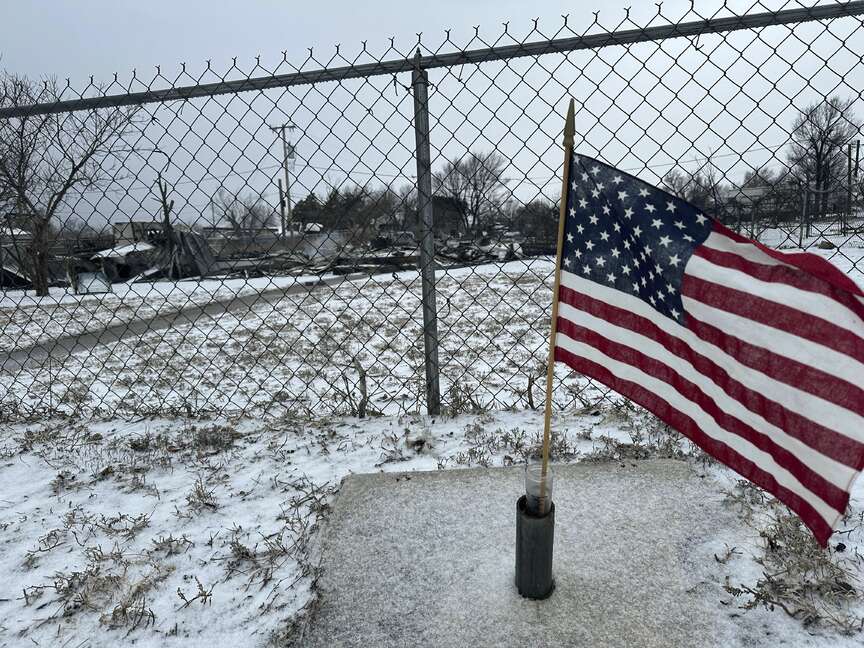 Snow covers a home that was destroyed by the Smokehouse Creek fire in Stinnett, Texas on Thursday, Feb. 29, 2024. The wildfire spreading across the Texas Panhandle became the largest in state history Thursday, as a dusting of snow covered scorched grassland, dead cattle and burned out homes and gave firefighters a brief window of relief in desperate efforts to corral the blaze.(AP Photo/Ty O'Neil)
Snow covers a home that was destroyed by the Smokehouse Creek fire in Stinnett, Texas on Thursday, Feb. 29, 2024. The wildfire spreading across the Texas Panhandle became the largest in state history Thursday, as a dusting of snow covered scorched grassland, dead cattle and burned out homes and gave firefighters a brief window of relief in desperate efforts to corral the blaze.(AP Photo/Ty O'Neil)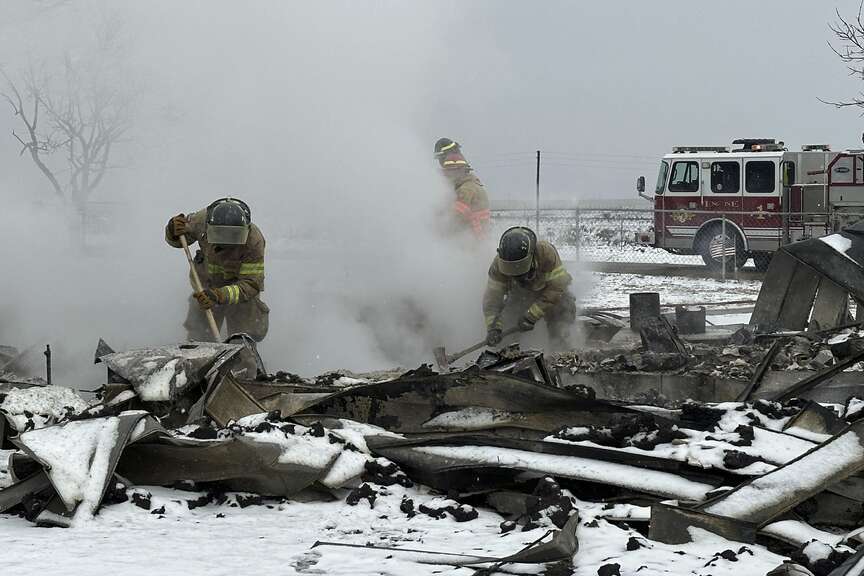 Firefighters work through rubble of burned homes from the Smokehouse Creek fire in Stinnett, Texas on Thursday, Feb. 29, 2024. A wildfire spreading across the Texas Panhandle became the largest in state history Thursday, as a dusting of snow covered scorched prairie, dead cattle and burned out homes and gave firefighters a brief window of relief in desperate efforts to corral the blaze. (AP Photo/Ty O'Neil)
Firefighters work through rubble of burned homes from the Smokehouse Creek fire in Stinnett, Texas on Thursday, Feb. 29, 2024. A wildfire spreading across the Texas Panhandle became the largest in state history Thursday, as a dusting of snow covered scorched prairie, dead cattle and burned out homes and gave firefighters a brief window of relief in desperate efforts to corral the blaze. (AP Photo/Ty O'Neil)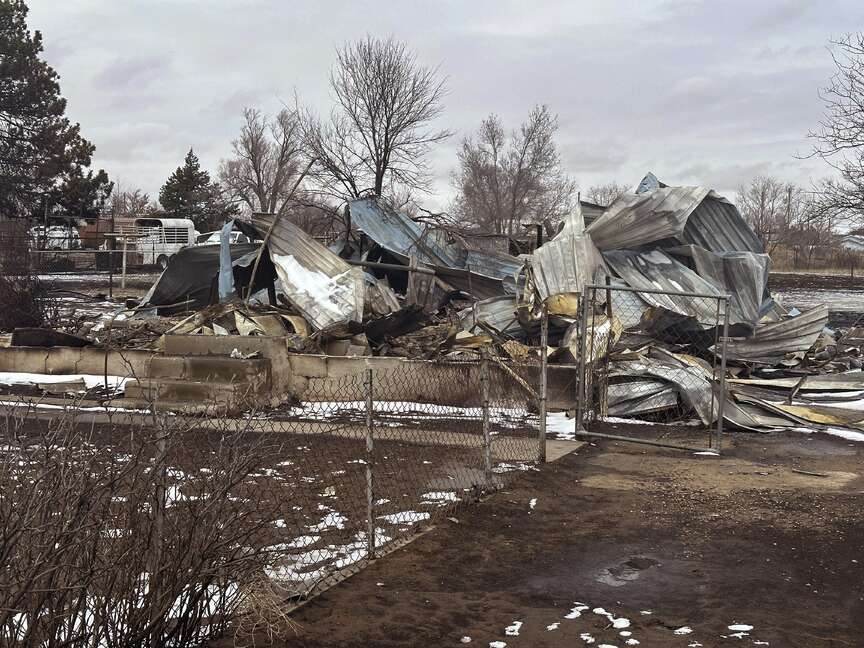 Snow covers a home that was destroyed by the Smokehouse Creek fire in Stinnett, Texas on Thursday, Feb. 29, 2024. The wildfire spreading across the Texas Panhandle became the largest in state history Thursday, as a dusting of snow covered scorched grassland, dead cattle and burned out homes and gave firefighters a brief window of relief in desperate efforts to corral the blaze.(AP Photo/Ty O'Neil)
Snow covers a home that was destroyed by the Smokehouse Creek fire in Stinnett, Texas on Thursday, Feb. 29, 2024. The wildfire spreading across the Texas Panhandle became the largest in state history Thursday, as a dusting of snow covered scorched grassland, dead cattle and burned out homes and gave firefighters a brief window of relief in desperate efforts to corral the blaze.(AP Photo/Ty O'Neil)
